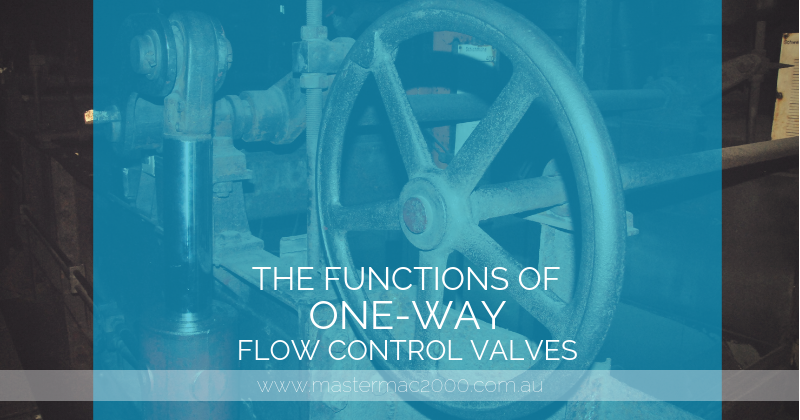The functions of one-way flow control valves

It has been known that flow control valves are used to regulate the flow rate and fluid pressure in a wide range of systems. The most basic kind of flow control valves consists of a changeable aperture, which closes to slow flow rate or opens to increase the flow rate.
Such valves are designed to deliver constant flow, and they operate based on the principal that such flow will be delivered if there’s a constant head loss (resistance to flow) across an orifice. This orifice was created for the function of delivering the required flow at a known head loss. There is this flow control pilot that observes the head loss across the orifice and modulates the valve to keep it constant. So, if the head loss is too high, the flow control pilot closes the valve; if the head loss is too low, the flow control opens the valve.
Control valves are being used because it provides an inexpensive solution to many concerns related to flow control. Typically, they are used on pipelines delivering water to multiple users to ensure that sufficient flow is distributed. They are made of brass, carbon steel, stainless steel, synthetics, and zinc.
One of the many types of flow control valves includes one-way flow control valves. Let us discover its functions and varieties.
ONE-WAY FLOW CONTROL VALVES
This type of flow control valve regulates the piston speed of pneumatic drives throughout the execution of return and advance strokes. This is done by suitable restriction of the compressed air flow rate in supply air or exhaust air direction. With this type of control valve, there is only one direction where the flow control works.
Double-acting cylinder with one-way flow control valve
Exhaust air one-way flow control function. There is an actual speed adjustment through the exhaust air flow control. What moves the piston between air cushions are the uncontrolled supply air and controlled exhaust air. This improves motion, and even with load changes.
Supply air one-way flow control function. Adjustable speed is present during the advance and return strokes. The flow rate is the same in both directions.
Single-acting cylinder with flow control valve
Flow control function in both directions. Speed adjustment on both sides through flow control is often implemented in cases of small or single-acting cylinders.
Single-acting cylinder with one-way flow control valve
Exhaust air and supply air one-way flow control function. The flow rate can be adjusted in varied ways in both directions. And the speed during the advance and return strokes are adjustable.
To learn more about one-way flow control valves, contact us at Mastermac2000.com.au.

About MasterMac2000: Your Trusted Pneumatic & Process Automation Partner.
LEADING THE INDUSTRY: Established in 1989, MasterMac2000 has grown to become one of Australia's largest privately owned pneumatic and process automation companies. We stock top-quality brands like Univer, Mack, Tolomatic, Mac, Piab, American, and Rotoflux in Brisbane.
SERVING QLD & NORTHERN NSW: We proudly service Queensland and Northern New South Wales for all your pneumatic and process equipment needs. Our mission is to provide the best pre and post-sales support while actively expanding our client base.
SOURCING HARD-TO-FIND PARTS: Not only do we stock quality components, but we also excel at sourcing those elusive, hard-to-find parts. With our extensive database and global network of contacts, getting the parts you require is as easy as a call to our highly skilled, professional sales team.
DEDICATED TO YOUR SUCCESS:
- Decades of expertise in pneumatics & process automation
- Carefully curated selection of world-class brands
- Exceptional sourcing capabilities for speciality parts
- Knowledgeable sales staff dedicated to finding solutions
- Unwavering commitment to customer service excellence
About The Author
Stuart Havill
Stuart Havill is the owner and manager of MasterMac2000, Queensland's largest privately owned pneumatic and process valve company.
With his early working career as a maintenance fitter for Boral in 1992, Stuart has spent his life in the field of pneumatics and process equipment. He gained extensive experience in plant design, maintenance, repairs, fabrication, and site management.
In 1996, he transitioned to a pneumatic sales technician role at MasterMac2000, where he excelled in key account management, providing cost-effective solutions, and managing a sales team of 9 employees.
Since 2002, Stuart has been the manager at MasterMac2000, overseeing the company's growth and establishing it as a leader in pneumatic automation and process valve engineering. His expertise spans customer training, CRM setup, industrial compressor sizing and installation, and turn-key project management.
Under Stuart's leadership, MasterMac2000 has been servicing the industry since 1988, with 5 full-time sales representatives covering northern rivers NSW, Queensland, Northern Territory, and PNG. The company prides itself on providing the best-priced solutions to all customers in the marketplace.
View Stuart’s LinkedIn profile to learn more about his expertise in pneumatics and process equipment.